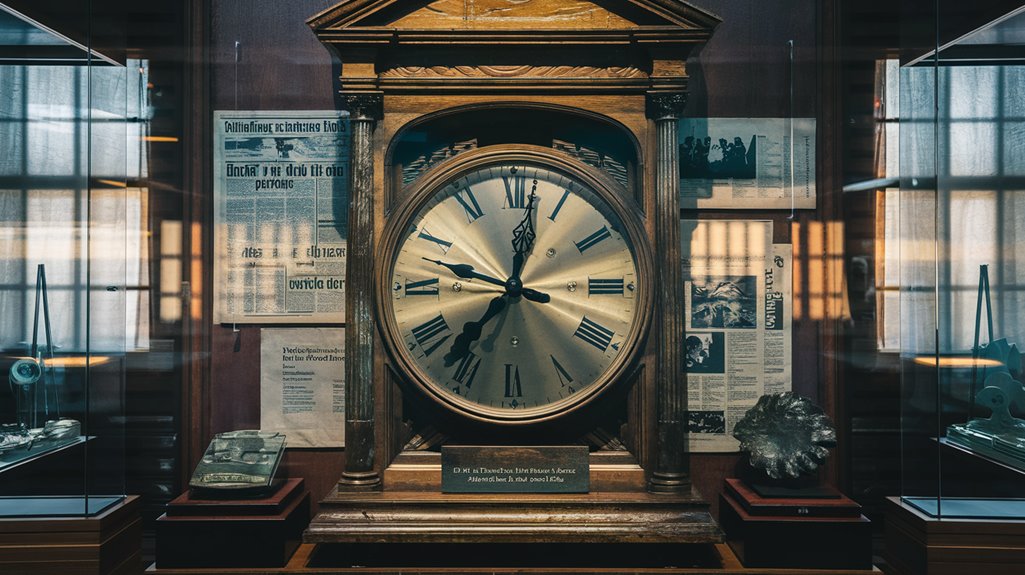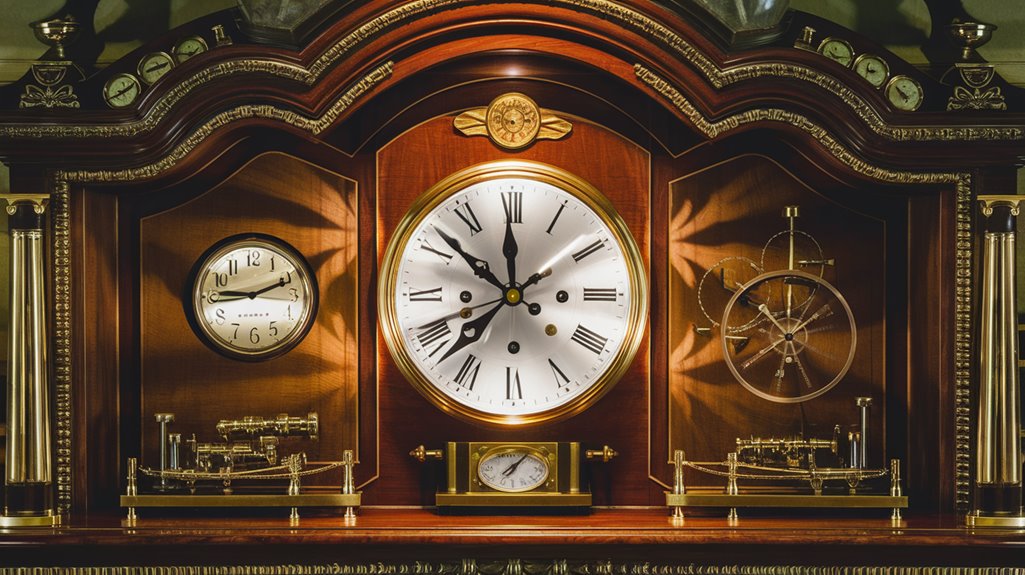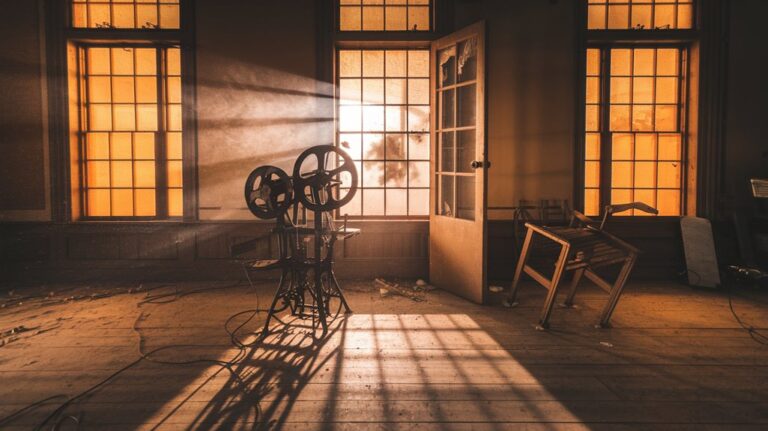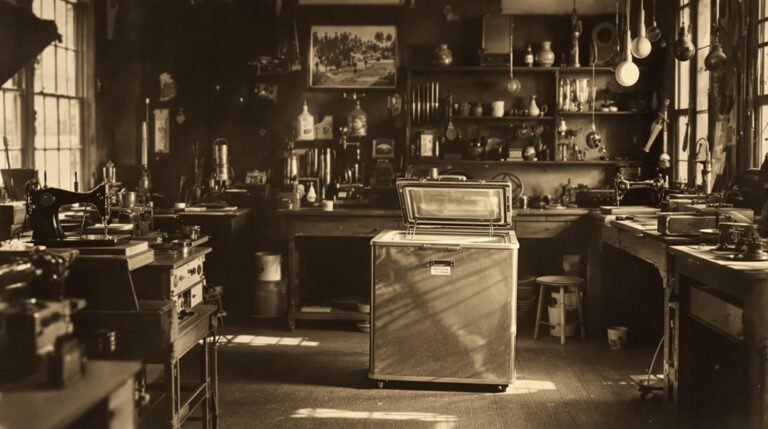The Doomsday Clock: Humanity’s Eeriest Alarm
You've probably heard of the Doomsday Clock, but you might not know that it started with a group of guilt-ridden atomic scientists who couldn't stay silent. Today, at 90 seconds to midnight, it's the closest we've ever been to symbolic catastrophe. What began as a warning about nuclear weapons has evolved into something far more complex and urgent. Behind this haunting timepiece lies a story of human innovation, regret, and an increasingly desperate race to prevent our own extinction.
Origins: The Manhattan Project's Unforeseen Legacy
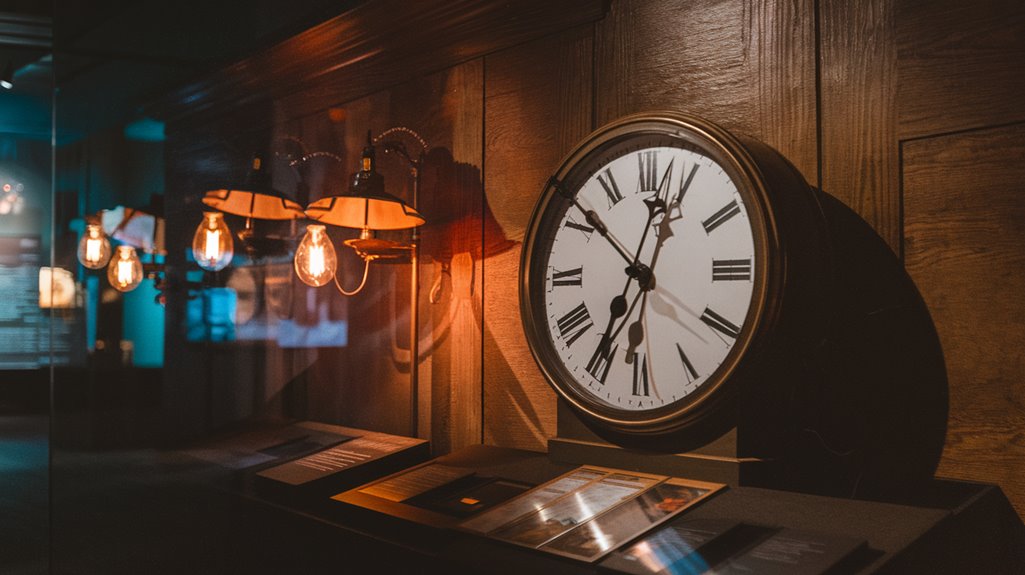
When scientists set out on the Manhattan Project during World War II, they couldn't have foreseen how their work would reshape humanity's future. The project's nuclear legacy extended far beyond its immediate military objectives, creating unforeseen consequences that still affect you today.
The environmental impact proved staggering, as nuclear testing contaminated vast areas, including the Marshall Islands, where communities continue to battle increased cancer rates. Children across America who consumed milk in the mid-twentieth century faced increased thyroid cancer risks from contaminated dairy products.
You'll find the project's reach extended surprisingly far – radioactive fallout from a single test in New Mexico managed to contaminate materials as far as Indiana.
The health ramifications of working with nuclear materials, coupled with persistent radioactive waste issues, sparked growing public awareness about technological risks.
This historical significance ultimately led Manhattan Project scientists to create a powerful warning symbol: the Doomsday Clock. In 1947, prominent scientists including J. Robert Oppenheimer spearheaded the creation of this iconic symbol to warn humanity about nuclear dangers.
Time Keepers: The Scientists Behind the Clock
Behind the infamous Doomsday Clock stands a dedicated group of scientists and experts who carefully monitor humanity's proximity to catastrophe. Their scientist motivations stem from a legacy established by founding members Albert Einstein and J. Robert Oppenheimer, who witnessed firsthand the devastating power of nuclear weapons.
Today, 18 distinguished experts from diverse fields engage in expert collaboration under the leadership of Rachel Bronson, the Bulletin's current CEO. The clock's current setting at 90 seconds to midnight represents the gravest assessment in its 75-year history. The clock was established to raise awareness after the atomic bombings of World War II.
You'll find specialists in nuclear science, climate change, and emerging technologies working alongside public health experts like Suzet McKinney and Asha M. George. Together, they assess global threats annually, consulting Nobel laureates and tracking critical data on nuclear arsenals, carbon emissions, and sea levels.
Their collective judgment determines the clock's position, carrying forward Eugene Rabinowitch's vision of using science to safeguard humanity's future.
Ticking Towards Midnight: Notable Changes Through History
Since its creation in 1947, the Doomsday Clock has served as humanity's stark warning system, beginning at seven minutes to midnight for purely aesthetic reasons.
Through historical resets, you'll notice the clock's hands shifting dramatically with global tensions. After the Soviet Union tested its first atomic bomb in 1949, the clock moved to three minutes to midnight. Artist Martyl Langsdorf created this powerful visual metaphor that continues to resonate today.
The darkest moments came in 1953 and recently in 2023, when it reached two minutes and 90 seconds to midnight respectively. Yet, there've been hopeful times too. The clock retreated to 17 minutes from midnight in 1991 following the START treaty – its most optimistic setting ever. The Science and Security Board now makes these crucial timing decisions after consulting with experts, a practice that began following Eugene Rabinowitch's death in 1973.
Today's settings reflect broader concerns, as the clock's keepers now consider climate change and cyber threats alongside nuclear dangers when determining humanity's proximity to catastrophe.
Beyond Nuclear: Modern Threats Reshaping the Clock
The modern era has dramatically expanded what constitutes a global threat. While nuclear warfare remains a critical concern, you'll now find the Doomsday Clock responding to climate change and technological risks that weren't even imaginable during its creation.
The Bulletin of Atomic Scientists now evaluates multiple factors that could trigger global catastrophe. The clock reached 100 seconds to midnight in 2022, marking a historic level of concern. A critical barrier to addressing these threats is the lack of governance at the international level to coordinate effective responses.
Three key developments reshaping the clock:
- Climate change's accelerating impact on global stability
- Artificial intelligence and biotechnology advancements that pose unprecedented risks
- Pandemic threats that expose worldwide system vulnerabilities
You're witnessing a shift in how we measure humanity's proximity to disaster.
Though some critics question whether combining these diverse threats dilutes the clock's message, it reflects today's reality: global security requires addressing multiple interconnected challenges simultaneously.
The 90-Second Warning: Understanding Our Current Status
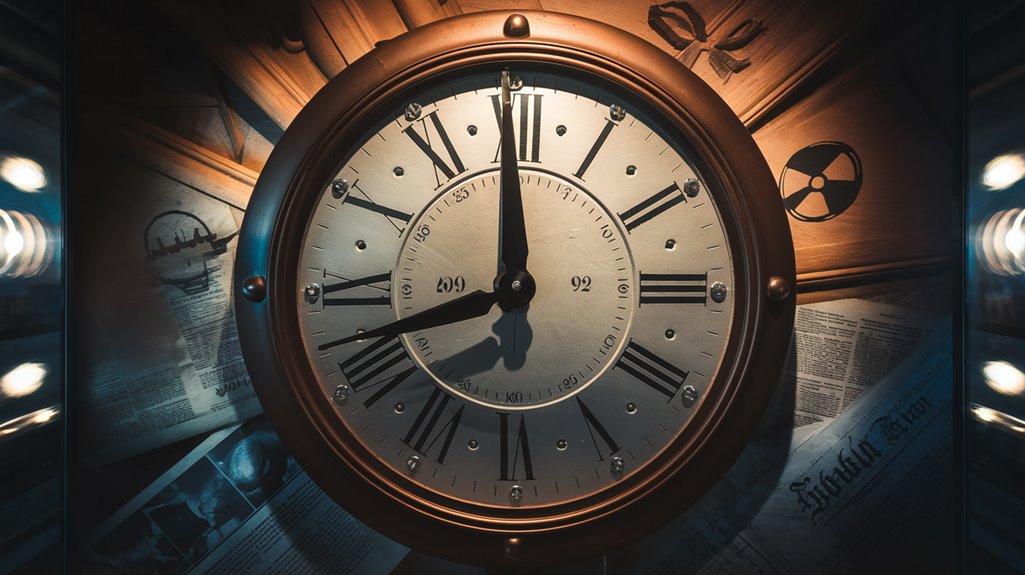
Humanity stands at its most perilous moment, with the Doomsday Clock now set at 90 seconds to midnight in 2024.
You're witnessing an unprecedented convergence of current threats that have kept the Clock at its closest point to catastrophe. The Russia-Ukraine conflict continues to escalate nuclear risks, while 2023's record-breaking temperatures highlight the mounting climate crisis.
Your urgency awareness is vital as disruptive technologies, including artificial intelligence and advances in life sciences, add new dimensions of risk. This critical assessment follows the Science and Security Board's biannual meetings to evaluate global threats.
Major world powers like nine nuclear-armed nations now possess weapons capable of global destruction, intensifying the risks we face collectively.
The Bulletin's assessment isn't just a warning – it's a call for your immediate action. While the situation appears dire, you can help move the Clock backward through collective effort and global cooperation.
Every second counts in addressing these existential challenges facing our world.
From Metaphor to Movement: Global Impact and Response
While scientific metaphors rarely catalyze global movements, the Doomsday Clock has emerged as a powerful symbol that transforms complex threats into actionable awareness.
The sobering shift to 90 seconds to midnight emphasizes the urgency of our global predicament. You'll find that it's driving unprecedented global collaboration among nations, experts, and communities to address existential risks. With nine Nobel laureates providing key guidance, the clock's warnings carry exceptional weight in global policy discussions.
The clock's impact has sparked three key responses:
- Youth activism has surged, with younger generations leading initiatives to combat climate change and nuclear proliferation.
- World leaders face mounting pressure to engage in diplomatic solutions, particularly regarding nuclear arsenals and environmental policies.
- Scientific communities are collaborating across borders to address emerging threats in artificial intelligence and genetic engineering.
You're witnessing a transformation as the clock moves beyond mere symbolism to become a catalyst for meaningful change, uniting diverse stakeholders in the fight for humanity's future.

